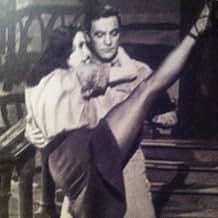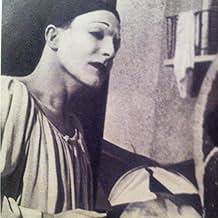Invitation to the Dance
- 1956
- 1 घं 33 मि
IMDb रेटिंग
6.4/10
1.1 हज़ार
आपकी रेटिंग
अपनी भाषा में प्लॉट जोड़ेंThree different stories are told through a notably unusual way - no words, just dance.Three different stories are told through a notably unusual way - no words, just dance.Three different stories are told through a notably unusual way - no words, just dance.
- निर्देशक
- लेखक
- स्टार
- पुरस्कार
- 1 जीत और कुल 1 नामांकन
Luigi Faccuito
- Specialty Dancer
- (बिना क्रेडिट के)
Diki Lerner
- Thief in 'Sinbad the Sailor'
- (बिना क्रेडिट के)
Paddy Stone
- Speciality Dancer
- (बिना क्रेडिट के)
Ian Wilson
- Man Exiting Stage Door in 'Ring Around the Rosy'
- (बिना क्रेडिट के)
फ़ीचर्ड समीक्षाएं
Invitation to the Dance is what you get when you take an artist at the peak of his abilities and allow his imagination to run wild. Gene Kelly--and some very talented people in all fields--integrated music and dance to create three distinct stories.
He reduces some scenes to their visual essences by using abstract or minimalist sets, aided by lighting effects. The third story includes cartoons, allowing Kelly to take his imagination beyond the bounds of human limitations and physics.
The performances are a synthesis of various dance and related forms (ballet, tap, jazz, mime, acrobatics, pop, and ethnic) with musical accompaniment (classical, jazz--cool and hot--ethnic, and pop).
Invitation to the Dance is a treat for any dance lover. It should be seen by all young students of dance.
It would be interesting to see this film they way Kelly originally imagined it, with him dancing in one section only.
He reduces some scenes to their visual essences by using abstract or minimalist sets, aided by lighting effects. The third story includes cartoons, allowing Kelly to take his imagination beyond the bounds of human limitations and physics.
The performances are a synthesis of various dance and related forms (ballet, tap, jazz, mime, acrobatics, pop, and ethnic) with musical accompaniment (classical, jazz--cool and hot--ethnic, and pop).
Invitation to the Dance is a treat for any dance lover. It should be seen by all young students of dance.
It would be interesting to see this film they way Kelly originally imagined it, with him dancing in one section only.
Invitation To The Dance took three years to make and it was a labor of love for Gene Kelly. Too bad for him that the public didn't take to it. But it was a film aimed at a highly specialized audience, those lovers of the ballet and other forms of dance.
Around the time that Kelly was winning plaudits for Singing In The Rain he pitched the idea to the MGM studio heads and having just starring in a film that many claim as the greatest musical ever made, he was in a position of considerable leverage. To cheapen costs MGM shot it over in the United Kingdom and this does explain Kelly's appearance in a pair of British films, Crest Of The Wave and The Devil Makes Three while putting together his dance film.
All this is according to the Citadel Film series book on Gene Kelly's films and then because the third and the best sequence was to be done with animated figures like Kelly's famous dance number with Jerry Mouse in Anchors Aweigh, MGM wanted to use Hanna&Barbera their crack cartoonists. Which meant him coming back to the USA to shoot that sequence. All in all it wasn't until 1956 that Invitation To The Dance finally made it before audiences.
The story I found most astounding was Andre Previn who was brought in to score the second sequence about a piece of jewelry making the rounds. MGM didn't like the original score, but the sequence had already been shot. So Previn had to score a ballet which had already been shot with another man's music. No small feat indeed and more production delays.
All this for what was really a film that should have had limited art house release. But MGM didn't do art house type films and they wanted their money back some how.
The three sequences all have Kelly in them, MGM would have it no other way. The first casts Kelly as a Pagliacci type clown in a circus dance drama. The second is as I described before. The third has Kelly as a sailor who gets a magic lamp and a genie appears. It is the best of them.
I'm sure Gene Kelly was disappointed in the lack of applause from a mass audience for Invitation To The Dance. It's a good film, but definitely for a special audience.
Around the time that Kelly was winning plaudits for Singing In The Rain he pitched the idea to the MGM studio heads and having just starring in a film that many claim as the greatest musical ever made, he was in a position of considerable leverage. To cheapen costs MGM shot it over in the United Kingdom and this does explain Kelly's appearance in a pair of British films, Crest Of The Wave and The Devil Makes Three while putting together his dance film.
All this is according to the Citadel Film series book on Gene Kelly's films and then because the third and the best sequence was to be done with animated figures like Kelly's famous dance number with Jerry Mouse in Anchors Aweigh, MGM wanted to use Hanna&Barbera their crack cartoonists. Which meant him coming back to the USA to shoot that sequence. All in all it wasn't until 1956 that Invitation To The Dance finally made it before audiences.
The story I found most astounding was Andre Previn who was brought in to score the second sequence about a piece of jewelry making the rounds. MGM didn't like the original score, but the sequence had already been shot. So Previn had to score a ballet which had already been shot with another man's music. No small feat indeed and more production delays.
All this for what was really a film that should have had limited art house release. But MGM didn't do art house type films and they wanted their money back some how.
The three sequences all have Kelly in them, MGM would have it no other way. The first casts Kelly as a Pagliacci type clown in a circus dance drama. The second is as I described before. The third has Kelly as a sailor who gets a magic lamp and a genie appears. It is the best of them.
I'm sure Gene Kelly was disappointed in the lack of applause from a mass audience for Invitation To The Dance. It's a good film, but definitely for a special audience.
Gene Kelly was a visionary. He was passionate about his art and he was a master.
If you are passionate about your art and creativity, you will enjoy this celebration of dance. There is no dialogue to explain what is happening. There is no person telling you what to think. Kelly brings you to a moment and allows you to make the most of it.
Did you see love, pain, joy, desire, frustration, anger...congratulations!
If you are passionate about your art and creativity, you will enjoy this celebration of dance. There is no dialogue to explain what is happening. There is no person telling you what to think. Kelly brings you to a moment and allows you to make the most of it.
Did you see love, pain, joy, desire, frustration, anger...congratulations!
this was Kelly's pet project- a film with dance, and only dance. No dialogue, only mime, movement and music. However to his disappointment, MGM shelved its release and when it was the film was released badly- it was too arty farty to be popular with the audiences at that time. Well, I love this film. It's adventurous and interesting, and it's worth a watch to appreciate all the work Kelly's put into this work, which showcases some of the greatest dancers across many styles. So go watch this under-rated film and you will be in awe of all the talent shown before your eyes!
No wonder INVITATION TO THE DANCE found no audience at the box office. The first two musical sequences, "Circus" and "Ring Around the Rosy" are monumental bores dragged down by pedestrian stories and, in the second one, inept use of camera trickery to speed up the action.
But the third, "Sinbad the Sailor," makes expert use of the Rimsky-Korsakov ballet score and makes dazzling use of animated effects, especially for the dancing between Kelly and a couple of Arabian guards which are highly original, intricate and amusing examples of combining live action with animation. It's the kind of originality sadly missing in the previously mentioned stories.
The "Sinbad" highlight almost makes up for the rest of the film with its own brand of originality--but alas, the first two sequences are enough to turn many viewers away from watching the final segment.
Summing up: Easy to see why this one failed miserably to attract a target audience with either high or low brow tastes.
But the third, "Sinbad the Sailor," makes expert use of the Rimsky-Korsakov ballet score and makes dazzling use of animated effects, especially for the dancing between Kelly and a couple of Arabian guards which are highly original, intricate and amusing examples of combining live action with animation. It's the kind of originality sadly missing in the previously mentioned stories.
The "Sinbad" highlight almost makes up for the rest of the film with its own brand of originality--but alas, the first two sequences are enough to turn many viewers away from watching the final segment.
Summing up: Easy to see why this one failed miserably to attract a target audience with either high or low brow tastes.
क्या आपको पता है
- ट्रिवियाGene Kelly's original intention was to make a film that would educate mainstream audiences about professional dancing in the world. To this end, he wanted to cast the greatest dancers in Europe for the four segments in leading roles. He himself would appear in only one - the Popular Song sequence, which ended up being cut. MGM, however, refused to allow the picture unless he appeared in all of them. Many of the professionals who worked in the film agreed that this was one of the film's great weaknesses.
- गूफ़During the "Scheherazade" sequence, the color of the palace guard's costume changes from green to blue.
- कनेक्शनEdited into American Masters: Gene Kelly: Anatomy of a Dancer (2002)
- साउंडट्रैकCircus
Music by Jacques Ibert
Performed by The Royal Philharmonic Orchestra, conducted by John Hollingsworth
Danced by Gene Kelly, Igor Youskevitch and Claire Sombert
टॉप पसंद
रेटिंग देने के लिए साइन-इन करें और वैयक्तिकृत सुझावों के लिए वॉचलिस्ट करें
- How long is Invitation to the Dance?Alexa द्वारा संचालित
विवरण
बॉक्स ऑफ़िस
- बजट
- $15,00,000(अनुमानित)
- चलने की अवधि
- 1 घं 33 मि(93 min)
- पक्ष अनुपात
- 1.37 : 1
इस पेज में योगदान दें
किसी बदलाव का सुझाव दें या अनुपलब्ध कॉन्टेंट जोड़ें
































